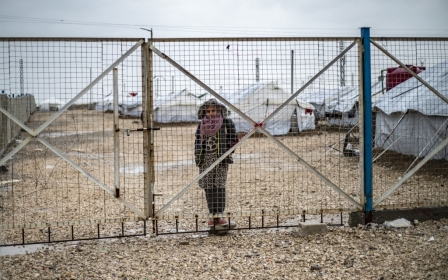In pictures: Syrians remember lost homes as war marks tenth anniversary
Musab al-Jarak, a displaced Syrian, pictured with his daughter inside their tent, shows an image of his former home bombed by the government's air force last year.
Jarak was wounded inside his house in the village of Deir al-Sharqi in the countryside of Maarat al-Numan when it was targeted.
"I can't move," he tells Middle East Eye, adding that while he has had operations to recover the use of his legs, he still struggles.
"The good thing about it is that I saw my house demolished before I moved out of it," he tells MEE. "This is a relief to me because my house will not be inhabited by anyone else."
But despite the tragedy, Jarak remains optimistic.
"I keep a picture of my house so that I will never forget it. I am sure that I will return to it one day, then I will rebuild it myself, and I will return to live in peace with my children."
Syria's uprising-turned-civil-war began 10 years ago on 15 March 2011. In the span of a decade, millions of people have been uprooted by the conflict, with around 6.6 million refugees having fled the country and a further 6.1 million Syrians who have been internally displaced.
No accurate figures exist for the number of those killed during the war, but as of 2018 there had been at least half a million fatalities.
The latest military campaign launched by President Bashar al-Assad and his ally Russia on the Idlib governorate, the last opposition stronghold, in northwestern Syria has led to the displacement of more than 1.5 million people to camps in the north of the country.
These people left behind house memories in towns and villages under full Assad control. As they sit in tents poorly equipped to handle the ravages of the seasons, many have held on to photographs of their lost homes.
(Photos by MEE correspondent Asaad al-Asaad, taken on 3 October 2020, Harbanoush camp, northwest of Idlib)
Ahmed Kashtim fled the eastern countryside of Maarat al-Numan with his family, including his four children: Ali, Muhammad, Marwan and Sahar. They now live in a camp near the town of Harbanoush, in northwest Idlib.
Kashtim keeps a picture of his house, which he left nearly a year ago, on the wall of his tent. Looking at it, he recalls many painful memories.
"I left my house under the bombing of warplanes more than a year ago, without taking anything with me. When I look at a picture of my house, I remember how I used to sit with my four children around me having fun and playing in our garden," he tells Middle East Eye. (MEE/Asaad al-Asaad)
One of Kashtim's children looks at a picture of their old family home.
"I had travelled to Lebanon to work in order to be able to build a house of my own and for my family," Kashtim says. "After working for more than 10 years, I was able to build this house, but unfortunately I did not continue to live in it because of a war that has not shown mercy to anyone."
(MEE/Asaad al-Asaad)
Amer al-Amer sits next to his son, holding his phone with a picture of the house he was forced to evacuate early last year. (MEE/Asaad al-Asaad)
Fatoum Sharaf al-Din, a single mother, lost her husband in a government bombing. She lives in a camp with her children in northwestern Idlib.
More than one million internally displaced persons live in camps in northern Idlib amid harsh conditions, having fled their homes under the pressure of intense air and artillery bombardment by Assad's military forces.
The UN estimates that 40 percent of Idlib's population of three million are internally displaced persons. (MEE/Asaad al-Asaad)
Mahasin al-Youssef, a 70-year-old Syrian, holding a picture of her house destroyed by aerial bombardment. (MEE/Asaad al-Asaad)
Middle East Eye delivers independent and unrivalled coverage and analysis of the Middle East, North Africa and beyond. To learn more about republishing this content and the associated fees, please fill out this form. More about MEE can be found here.




